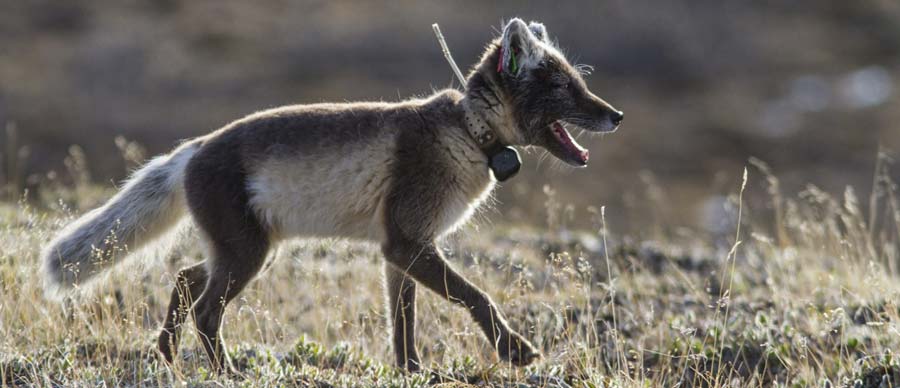← Back
Why Arctic foxes travel long distances?

The Arctic foxes have been noticed as travelling very long distances over the whole Arctic regions. Long time series of tracks retrieved by Argos enables to analyse this behaviour to understand why they might go so far, and whether they are staying there, at which period of their life, etc.
Arctic foxes (Vulpes lagopus) are small carnivores of the Arctic areas. Despite their size – they weight about 3 kg –, they are long-range travellers across land and sea ice (see Unlocking the mysteries of the Arctic fox, From Svalbard to Canada, the long travel of an arctic fox tracked by Argos or Siberian Arctic fox on the move ).
Long-distance dispersals (i.e. long-range travels not in the frame of seasonal migrations), and their implications have been a question for a long time now, since C. Darwin discussed it in length in The Origin of Species in 1859. In the past two or three decades, satellite telemetry enabled to make a giant leap on this topic, by monitoring the whole length and detailed path of animals’ travels.
Global coverage allows to track animals independently of their locations, and this over several months (or even years). Most studies had been led on birds, though, while terrestrial mammals do have such behaviours, especially carnivores. Arctic foxes have been known for long-range travels, with impressive distances sometimes recorded. Do these qualify as “long range dispersal”? Is a life stage more likely to have such behaviour than another?
Using a long-term database of Arctic fox tracks
170 individuals (148 adults and 22 juveniles) have been equipped with Argos PTT collars along 13 years on Bylot Island (Nunavut, Canada) by the Canada Research Chair on Northern Biodiversity, Université du Québec à Rimouski. Bylot Island is surrounded by sea ice from late October to late July. This enables Arctic foxes to leave the island and travel. Most of those excursions seem to be within 80 km of their origin point, but some of the foxes are going further. Those were the ones which were considered as “long-distance dispersal” individuals, at least when they did not return permanently to their territory.
On the 155 individuals which locations were analysed, 10 juveniles and 27 adults engaged in long-distance dispersal across the Canadian High Arctic. This represents close to two-third of the juveniles tracked (62.5%, 6 having not been tracked for more than 2 weeks due to mortality or transmitter failure), and nearly 20% of the adults, which was much more than expected, especially for the juveniles. Emigration dates of juvenile were from July to October and clearly peaked in August; for adults, they were from October to April without noticeable peak.
Leaving Bylot island, foxes spent nearly half of their transience time on sea ice, with differences in routes between juveniles and adults. For both age classes impressive distances were recorded, over 6000 km for some long-range dispersal Arctic foxes. Permanent settlement in a new territory was identified for only 3 juveniles and 10 adults, which represent about 30% for both age classes.
![Long-distance dispersal paths of juveniles (a1; 10 individuals) and adults (b; 27 individuals) from Bylot Island between 2007 and 2021. a2 shows the paths of interrupted or short distance natal dispersal. Dots at the end of the paths indicate successful dispersal with immigration (white) or tracking ending during transience by collar failure (gray) or fox death (black). (from [Gravel et al., 2023])](https://www.argos-system.org/wp-content/uploads/2023/03/rsos220729f02.jpg)
Long-distance dispersal paths of juveniles (a1; 10 individuals) and adults (b; 27 individuals) from Bylot Island between 2007 and 2021. a2 shows the paths of interrupted or short distance natal dispersal. Dots at the end of the paths indicate successful dispersal with immigration (white) or tracking ending during transience by collar failure (gray) or fox death (black). (from [Gravel et al., 2023])
Understanding long-distance dispersal of arctic foxes
A 13-year long dataset, and the length of each individual track enabled to observe variability in Arctic fox behaviours, at both inter and intra-annual scale. Some findings were expected, such as the larger number of juveniles than adults involved in long-distance dispersal, seasonal synchronised emigration for the former and not the latter. Others surprised the scientists, such as the low success for both ages alike of resettlement (immigration), or the use of different dispersal routes. Final settlement of successful immigrants show that reproduction is probably not the cause, since they arrived too late to allow birthing and pup rearing.
The high rate of movements from Bylot island, and the trend to emigrate could come from a high local fox density compared to low resources, and from the relative easiness of leaving the area throughout most of the year.
Using the data for other individual characteristics could be of interest, to see if other factors than age are influencing the long-distance dispersal and success. However, decreasing sea ice extent and duration will affect such Arctic fox movements. Since those participate to an important connectivity between the different populations of Arctic foxes on all continents, it could have important impacts on the species.
Paths of all the 37 long-range dispersal arctic foxes (from [Gravel et al., 2023])
Reference & links
- Gravel R, Lai S, Berteaux D. 2023 Long-term satellite tracking reveals patterns of long-distance dispersal in juvenile and adult Arctic foxes (Vulpes lagopus). R. Soc. Open Sci. 10: 220729. https://doi.org/10.1098/rsos.220729
- Twitter : https://twitter.com/Arctic_paws/status/1620868012478988288?cxt=HHwWgIDU-dO3vf4sAAAA
- Entrevue radio (CBC – Canada) : https://www.cbc.ca/radio/quirks/feb-4-dolphins-and-fishers-work-together-arctic-foxes-epic-treks-and-more-1.6734849
- Nature : https://www.nature.com/articles/d41586-023-00230-x
Main Photo: an arctic fox with an Argos PTT in summer (credit Nicolas Bradette)


